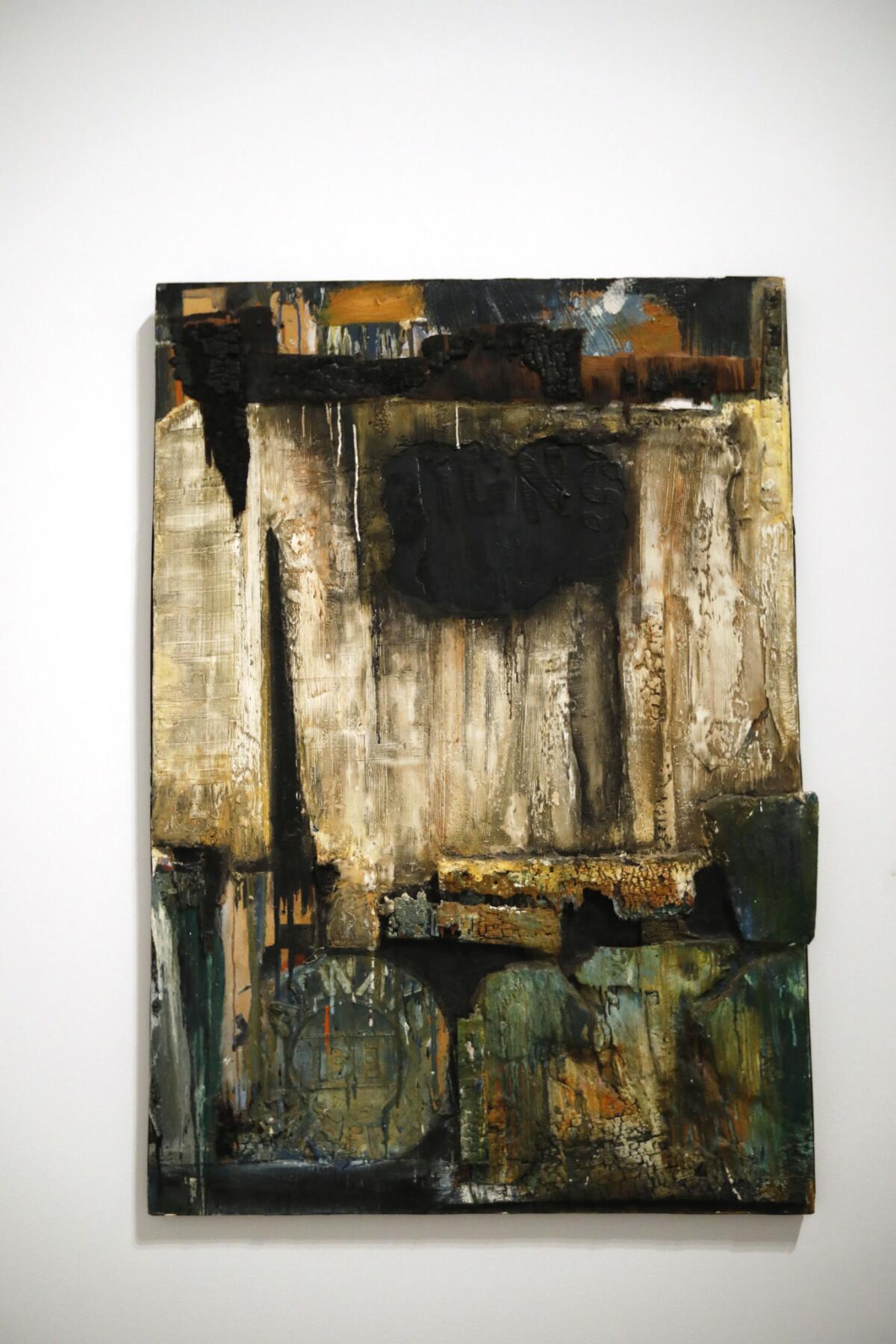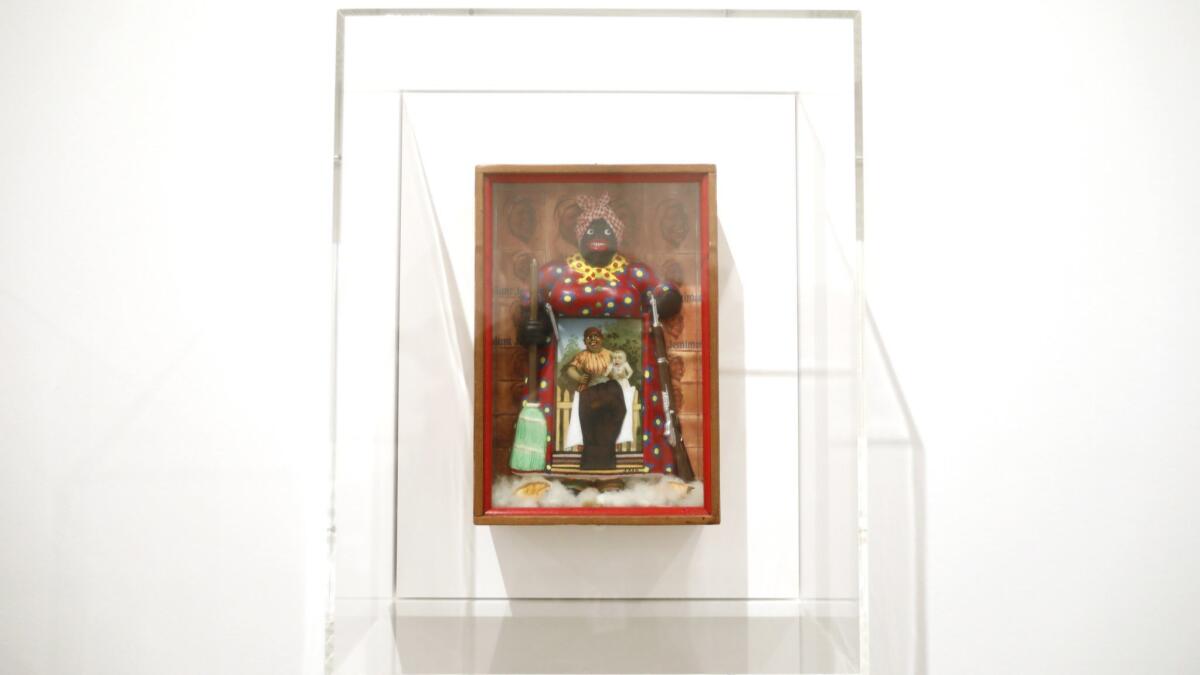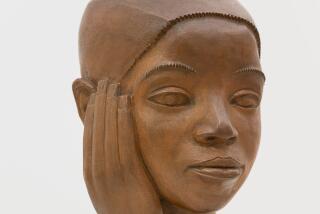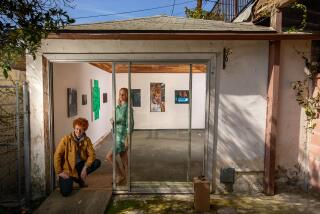The Broad’s ‘Soul of a Nation’: Art from the rubble of Watts
- Share via
In the 1960s and 1970s, assemblage — the practice of creating artwork from discarded items — gave black L.A. artists the chance to reclaim their community while calling out the indignities they faced. Central players in the movement — including Noah Purifoy, Betye Saar, Melvin Edwards and John Outterbridge — found inspiration for their assemblage from the 1965 Watts riots.
The art was bold: In her 1972 work “I’ve Got Rhythm,” Saar emblazoned part of a metronome with racist headlines and its pendulum with a black skeleton. One headline is circled in red: “Lynched After Refusing to Dance on White’s Command.”
For the record:
10:30 a.m. March 22, 2019An earlier version of this article referred to Sarah Loyer as an assistant curator; she is an associate curator. The museum’s scheduled was incorrectly listed as Mondays-Saturdays; it is open Mondays-Sundays.
An amalgamation of tin cans, rusted nails and other cast-off materials make up Outterbridge’s 1969 “Containment Series,” a collection of rectangular pieces exploring the concept of constraint. Daniel LaRue Johnson’s early 1960s black box series confronted racial violence of the civil rights movement. “The Big N” shows a doll hand ensnared in a mousetrap, surrounded by a chain link fence, all coated in a black lacquer paint.
These works go on view Saturday at the Broad in “Soul of a Nation: Art in the Age of Black Power 1963-1983,” highlighting the rich history of black assemblage in L.A.
For many years, I had been collecting derogatory images of black people, and I decided to use those images, to recycle them and transform them.
— Betye Saar
The exhibit follows assemblage but also painting, photography, sculpture and performance art through the civil rights and black power movements with more than 60 artists and about 150 works of art. “Soul of a Nation” also delves into artists’ collective power, highlighting Spiral group, Harlem’s Kamoinge Workshop for photographers, Chicago’s AfriCobra and other groups.
Organized by London’s Tate Modern, the exhibit opened in 2017 before traveling to Crystal Bridges Museum of American Art in Arkansas and the Brooklyn Museum. The Broad show runs until Sept. 1 and features three distinct galleries dedicated to local artists.
One gallery pays respect to the 1971 LACMA exhibition “Three Graphic Artists,” showing works by Charles White, David Hammons and Timothy Washington. The exhibit was the result of a campaign started by the Black Arts Council, founded by LACMA employees Claude Booker and Cecil Fergerson in 1968 to demand the museum show works by black artists.
Another gallery focuses on assemblage, exploring how an art movement can be born from literal ashes.
In August 1965, crowds gathered in Watts as a white California Highway Patrol officer arrested a young black man suspected of drunk driving. It was the spark that catalyzed the Watts riots, igniting long-bubbling tension over police brutality, segregated housing and education, and other issues. For six days the community raged and burned — cafes, markets, shoe stores — reduced to rubble. The aftermath was devastating: 34 people died, more than 1,000 were injured and an estimated $40 million in property was damaged.
But out of the wreckage came an arts reckoning.
In his essay “Before and After Watts: Black Art in Los Angeles,” UCLA African American studies scholar Paul Von Blum writes that the uprising forced public dialogue about race and pushed government agencies to fund social and cultural programming in the city.
Before the Watts riots, black people were struggling to secure a place in American society, said Daniel Widener, history professor at UC San Diego and author of “Black Arts West: Culture and Struggle in Postwar Los Angeles.” After the rebellion, “black people as a whole are saying, this is a sick place that has to change if we’re going to be part of it. If it won’t change, we have to force it in a new direction.”
The Watts uprising played a central role in both the black assemblage movement and efforts to elevate the work of black artists in mainstream institutions.
Regarded as the father of the black assemblage movement, Purifoy scoured the streets of Watts almost immediately after the fires died down with his artist friend Judson Powell. Purifoy and Powell found beauty in the debris, digging through the rubble and loading up their wagon with what they called junk.
“We took our wagon into the streets and looked for things that looked beautiful: the signs of neon, the signs that had melted and broken and pieces that were infused with glass,” Powell recalled in a 2015 Times interview. “They looked like beautiful jewels in the sunshine.”

Several of Purifoy’s Watts sculptures from the rebellion are on view at “Soul of a Nation.” Purifoy created “Watts Riot,” about 3 feet wide and 4 feet high, using scorched wood, plaster paint and signage. His whimsical “Totem” is a sculpture constructed of shoe trees, tobacco pipes and wheels and adorned with narrow wooden spikes.
Born in 1917 in Alabama, Purifoy spent a career as a teacher and studied social work before graduating from Chouinard Art Institute in 1956. He was 49 when he made “Watts Riot.” The artist, who died in 2004, was also a founding director of the Watts Towers Arts Center at the site of the massive assemblage landmark built by Simon Rodia.
In spring 1966, Purifoy organized the traveling show “66 Signs of Neon” featuring assemblages made from artifacts of the Watts uprising. The exhibit featured 66 works by Purifoy, Powell and other artists and influenced key figures in the assemblage movement, including David Hammons and Outterbridge.
“It was an epically successful show,” said Sarah Loyer, an associate curator at the Broad. “It was … looking at the symbolic moment of the Watts rebellion in L.A. and what that meant locally and nationally.”
Black assemblage art is inherently revolutionary and political, Widener said. And in a time when black artists were barred from mainstream museums, using nontraditional methods was one way to build a legacy.
“It breaks with the American idea that when something is done you throw it away,” the professor said. “It’s got renewal at its heart, which is a radical message for people who are told they’re disposable and in a country that praises disposability.”
The prolific Saar was born in L.A. in 1926. After a career in design, she turned to assemblage, often searching flea markets and garage sales for her found items. For Saar, assemblage was a tool to express her rage, beginning with the assassination of Martin Luther King Jr.
“For many years, I had been collecting derogatory images of black people, and I decided to use those images, to recycle them and transform them into an army against racism,” said Saar, 92, by email.
Her first warrior was her iconic work made in 1972, “The Liberation of Aunt Jemima,” which is on view at “Soul of a Nation.” The shoe-box-size assemblage is derived from a stereotypical mammy figurine, except this one is armed with a grenade and a rifle. “She was a symbol for both black civil rights and for women’s rights,” Saar said.


“Soul of a Nation” dedicates another gallery, re-creating Saar’s first survey exhibition at Cal State L.A. in 1973, to her work exploring spirituality and assemblage.
Similarly, King’s assassination had a profound impact on Outterbridge, now in his mid-80s. Growing up in depression-era North Carolina, Outterbridge inadvertently came to know assemblage through his father, an avid salvager. After serving in the military, Outterbridge moved to L.A. from Chicago in 1963.
The artist frequently used hair, wood scraps and rags for his acclaimed doll sculptures. “About Martin,” one of his works in “Soul of a Nation,” is Outterbridge’s 1975 homage to the civil rights leader. Inside a wood cabinet, a teeny suit jacket hangs above a laundry receipt made out to King, stamped with the words “Paid in full.”
During the civil rights and black power movements, assemblage art communicated that black freedom could emerge from ruins. Now, as the world grapples with the challenges of sustainability, the art form might take on a new meaning.
“Out of the wreckage of America comes a sustainable way of living,” Widener said. “Most people don’t draw the link between black liberation and ecology, but it’s there.”
♦ ♦ ♦ ♦ ♦ ♦ ♦ ♦ ♦ ♦
‘Soul of a Nation: Art in the Age of Black Power 1963-1983’
Where: The Broad, 221 S. Grand Ave., L.A.
When: Exhibition opens Saturday, ends Sept. 1; museum open Tuesdays-Sundays (advance timed entry tickets recommended)
Admission: $12-$18; free entry 5-8 p.m. Thursdays with last entry at 7 p.m. (general admission to the rest of the museum is free)
Info: (213) 232-6200, thebroad.org
More to Read
The biggest entertainment stories
Get our big stories about Hollywood, film, television, music, arts, culture and more right in your inbox as soon as they publish.
You may occasionally receive promotional content from the Los Angeles Times.











